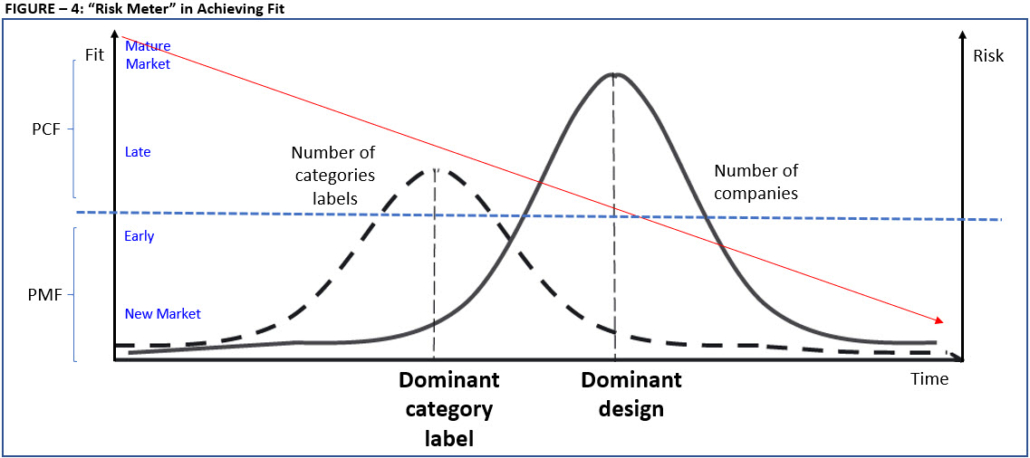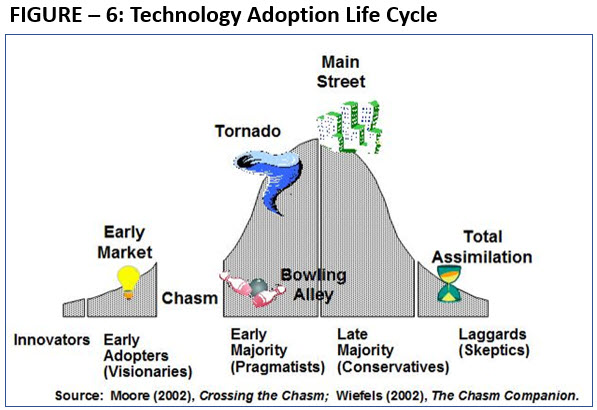Part-2: Connecting the Dots
The concept of Product-Market Fit (PMF) is deeply embedded in startup culture. For entrepreneurs, it remains one of the most difficult challenges in building a successful startup. For investors, achieving PMF signals a growth phase. And while the definition has evolved over the years, finding a road map to achieve PMF is still elusive.
Marc Andreessen’s blog post, published in 2007, introduced us to the concept of PMF. Andreessen explains that “the market” is what matters most between the team, product, and market. He states that no matter how good or bad your product is, the market or lack thereof is the deciding factor if your product succeeds. He says, “Product-market fit means being in a good market with a product that can satisfy that market.” Anyone that has brought a product to market can appreciate the achievement in finding the fit between the product and the market it serves. (BTW, I’d love to know his definition of a “good market!”)
Ultimately, the design delineates a new category
In Part –1, we learned about the academic research, published in 2013, that I refer to as “Category Dynamics.”² The research demonstrates that what delineates a new category is ultimately the product design, not the problem it solves or for the benefits it delivers. This definition reshapes how we think about PMF. It is a dramatic departure from prior approaches and hypotheses on this topic. If you are a startup or an existing company entering into a nascent market or mature category, this definition provides a road map for your product. If you are an investor, there is a “risk meter” that separates a nascent market from a mature category that you should pay attention to. It requires a baseline understanding of Category Dynamics.
A market does not always have a category, but a category is always part of its market
This statement is the central tenet in rethinking PMF. In our current understanding of PMF, it would require one definition when the category does not exist, as in a new or early market, and another definition when the category is established, as in a mature market. This bifurcation is why we need to evolve the concept of PMF. To understand this central tenet requires (1) Understanding how categories emerge and (2) Providing a framework that forks PMF. To illustrate this separation, I also provide one thought experiment with four use cases.
1. Understanding how categories emerge

Category Dynamics is the result of studying the Smartphone industry. As shown in Figure – 1, a new industry will bring about a proliferation of category labels. There were more than 200 category labels in describing the early Smartphone device.² See Figure – 2 for examples of labels used to introduce these early devices. Ericsson is credited with coining the term “Smartphone.” As the industry matures, a dominant category label is introduced.¹ “Producers, users, innovators, bloggers, advertisers, writers and analysts all contribute to a label being dominate and infused with specific meaning.”² Once the dominant category label is established, it is a race for the dominant design.² The research shows that the optimal time to enter an emerging category is after the dominant category label is introduced. As the market matures, a dominant design is introduced, and the category is then firmly rooted as part of its market. Users will know what to expect from a product in the same category. By definition, until the dominant design emerges, the category cannot exist, even when the dominant category label has been established. The emergence of a dominant design is the demarcation of the category. It is now a mature market.

In the case of the Smartphone, Apple entered the market after the label was established and created the dominant design as we know it today. While Ericsson is credited with coining the dominant category label, the benefits went to the company that created the dominant design!
2. Providing a framework that forks PMF
Category Dynamics tells us that for a category to exist, it must have both a dominant label and design. In a new or early market (nascent), while it may or may not have a dominant category label, it would not have a dominant design. This is the life cycle of a category not yet rooted as part of its market. As shown in Figure – 3, PMF is the perfect phrase in describing a nascent market. If you are a startup with two customers, half of which love your product, you are at PMF.³ If you are a startup with twenty customers, and >40% of them “must have” your product, you are at PMF.³ In essence, to achieve PMF in a nascent market, the hurdle is based on the plurality of your customers needing your product. Think of this as the “Early Market” from Geoffrey Moore’s “Crossing the Chasm.”
Helpful references: Survey tool to measure PMF. Article on Prototype, MVP and PMF.⁴

To bring balance to a category, the market must be comprised of more than one seller, meaning there is competition. Once a dominant design is established, the category is rooted as part of its market. The hurdle for PMF is now different than in a nascent market. There are “rules of membership” to be part of the category. “Products that do not conform to these characteristics face penalties in the market.”² As shown in Figure – 3, it is therefore necessary to fork PMF to something new; “Product-Category Fit” (PCF). The demarcation between PMF and PCF is the emergence of a dominant design. This aligns nicely with Crossing the Chasm and the behavior of the Pragmatists from the Mainstream market. The Pragmatists require the market to reach maturity and offer competitive options in order to make a purchase.
Category Dynamics helps investors make informed decisions about the markets in which they invest

For investors, there is a “risk meter” associated with the definition of PMF and PCF due to the boundary between a nascent and mature market. In Figure – 4, the meter is strictly about achieving “fit.” Reaching PMF in the early stages is difficult, hence more risk. As we know, the overwhelming majority of startups fail. PMF signals that the market is responding favorably to the startup, but it is still too early to determine sustainability. Bear in mind that the market may never mature to the point of establishing the category. PCF is a signal that (1) the market is sustainable (2) there are rules of membership for the category and (3) viable competition. The entity that defines the dominant design reaps the benefits. The research also displaces the notion that “first movers” have all of the advantage.
Illustrating PMF and PCF using a thought experiment
To illustrate PMF and PCF, using real examples, I created one thought experiment across 4-different markets, as shown in Figure – 3. To keep this article short, I have included these use cases in a separate document. Click this link to download the document. The use cases include:
- Mature Market: Email Marketing
- Late Market: Sales Engagement
- Early Market: Influencer Marketing
- New Market: String Theory Marketing
The thought experiment is meant to demonstrate that you can define PCF for a late or mature market based on the design without having to leave your couch. For a new or early market, PMF is based on market response.
Conclusion

It was Everett Rogers who originated the “diffusion of innovations” theory. The familiar bell shaped curve and terms like “early adopters” and “early majority” stem from his research. People can fall into different categories for different innovations. As an example, I am an early adopter of electric cars (Tesla), but would be a laggard for digital video recorders (TiVo).
It was Geoffrey Moore who applied Roger’s research and identified a “chasm” that exists between the early adopters and early / late majority. Moore created personas such as “Visionaries” as the early adopters and “Pragmatists” as the early majority to give context to their behaviors. He segmented these categorizations into the Early and Mainstream market to emphasize the chasm. See Figure – 6. Technology Adoption Life Cycle
As it turns out, the behaviors of the Early and Mainstream markets fit nicely within the framework of PMF and PCF. I simply used the research from Fernando Suarez and Stine Grodal in connecting the dots to rethink PMF. Their research provides a window to understand and take advantage of the dynamics through which new categories emerge.

The central tenet in finding “fit” is that a market does not always have a category, but a category is always part of its market. It brings clarity to an early market where the term PMF is about the plurality of your customers needing your product. At this early stage, the dominant category label may or may not exist, but there is no dominant design. PCF demarcates the transition from an early market to an established category once the dominant design has emerged. New entrants into the category now have a road map for their product.
Categorical positioning is an essential tool for every startup or existing company entering into a nascent market or mature category. For investors, it provides a simple framework in which to make an informed decision about the market in which you are investing.
Click this link for Part-1
REFERNCES
1. Fernando F. Suarez | Stine Grodal | Aleksios Gotsopoulos, “Perfect timing? Dominant category, dominant design, and the window of opportunity for firm entry“, Wiley Online Library, December 2013
2. Fernando F. Suarez | Stine Grodal, “Mastering the ‘Name Your Product Category’ Game“, MITSloan Management Review, Winter 2015
3. Sean Ellis, “Using Product/Market Fit to Drive Sustainable Growth“, Growth Hackers, April 5, 2019
4. Christoph Auer-Welsbach, “From MVP to Product/Market Fit — Why Definitions Matter“, Medium.com, Dec 4, 2015






